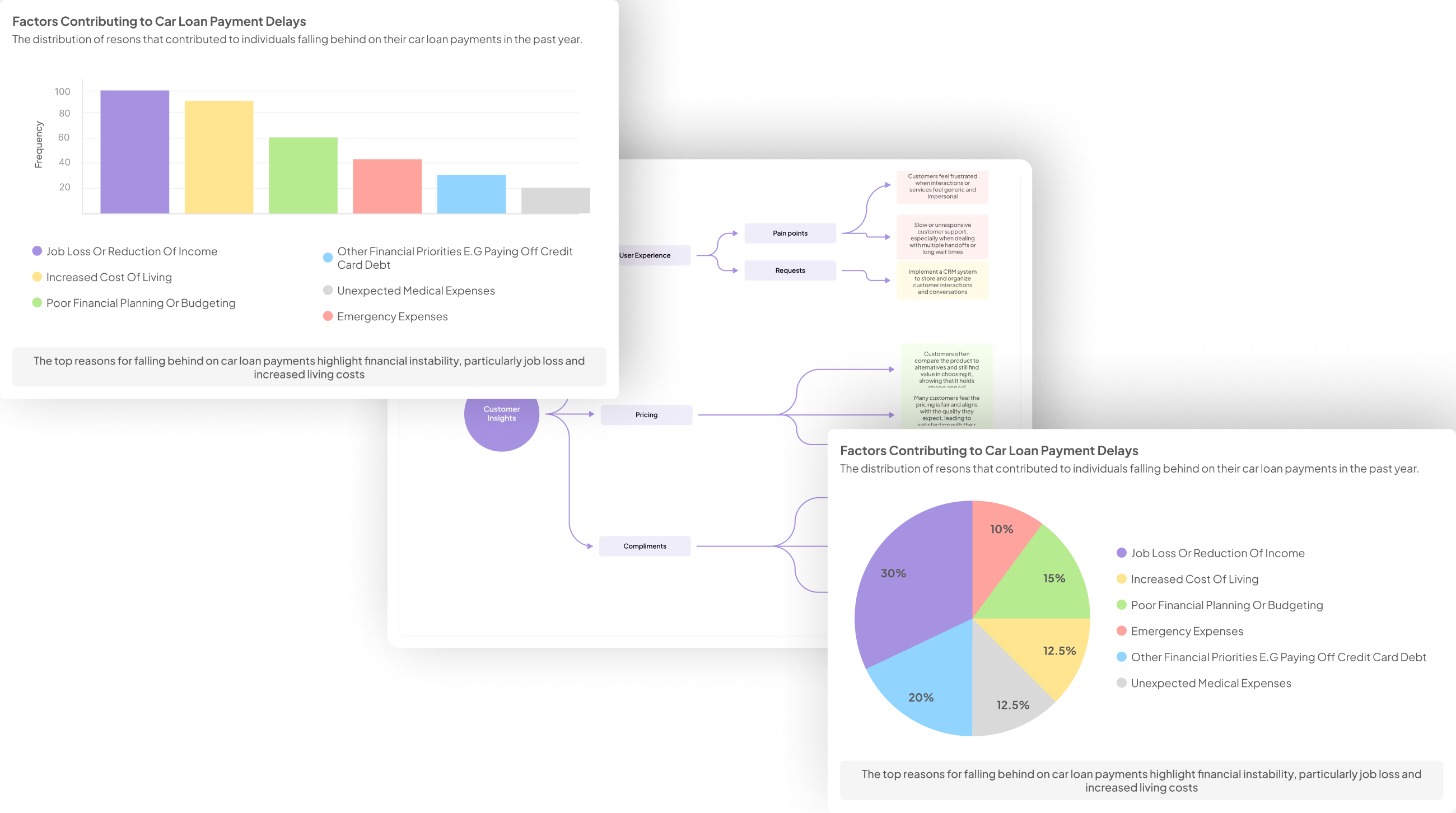How to Analyze Organizational Culture Feedback
-
Bella Williams
- 10 min read
Analyzing organizational culture feedback begins with understanding its significance in shaping a positive workplace environment. Culture Feedback Analysis helps to uncover employee sentiments, revealing strengths and areas for improvement within the organization. This process fosters a culture of transparency and openness, facilitating better employee engagement and retention.
In this introduction, we'll explore the concept of Culture Feedback Analysis, emphasizing its role in guiding strategic decisions. By effectively gathering and interpreting feedback, organizations can implement meaningful changes. Ultimately, this approach leads to a healthier culture, driving overall success and enhancing employee satisfaction.
Generate visualizations from your qualitative data. At Scale.

Understanding Culture Feedback Analysis
Understanding Culture Feedback Analysis involves dissecting the insights gathered from organizational feedback. This process offers a pathway to comprehend employee sentiments and attitudes toward the workplace environment. By systematically analyzing the data, organizations can identify areas of strength and opportunities for improvement. The emphasis is on recognizing themes within the feedback, whether positive or negative, and grasping their implications on culture.
In this analysis, it’s crucial to categorize feedback effectively. This could include grouping data into themes like communication, leadership, or work-life balance. Additionally, utilizing both qualitative and quantitative data aids in gaining a holistic understanding. An organized approach ensures that actionable insights emerge, guiding the organization towards a more positive culture. By focusing on the feedback findings, organizations can define necessary changes, fostering a more supportive and engaged workforce.
Importance of Culture Feedback Analysis
Analyzing culture feedback is crucial for fostering a healthy organizational environment. By engaging in culture feedback analysis, organizations can gain valuable insights into employee perceptions and behaviors. Understanding these aspects allows leaders to identify strengths and areas needing improvement, driving employee engagement and satisfaction.
One significant benefit of culture feedback analysis is its ability to inform decision-making. When leaders make informed choices based on feedback, they are more likely to align their strategies with the workforce's needs. Additionally, this analysis facilitates open communication, empowering employees to voice their opinions without fear. Lastly, culture feedback analysis can uncover hidden issues, promoting a proactive approach to addressing potential conflicts before they escalate. By prioritizing culture feedback analysis, organizations can create a more inclusive and responsive workplace, ultimately enhancing overall productivity and morale.
Common Methods Used in Culture Feedback Analysis
Analyzing culture feedback can involve several common methods that provide valuable insights. Surveys are one of the primary tools used for this purpose. They can capture the collective sentiment about the organizational culture, assessing factors like job satisfaction and communication. Open-ended questions within surveys allow individuals to express their thoughts in their own words, revealing nuanced perspectives.
Another effective method is focus groups, which encourage in-depth discussions among employees about cultural elements. These discussions can unearth deeper feelings and experiences that surveys might not fully capture. Observations of office interactions also provide vital context, showing how values manifest in day-to-day behavior. Finally, analyzing existing documents, such as internal communications or performance reviews, can highlight alignment or misalignment with stated cultural values. Each method contributes distinctively to a comprehensive culture feedback analysis, facilitating a more informed understanding of the organizational environment.
Evaluate Performance on Customer Calls for Quality Assurance.
Steps for Effective Culture Feedback Analysis
To analyze organizational culture feedback effectively, begin with gathering data from various sources. Collect insights from employee surveys, focus groups, and one-on-one interviews. This aims to capture a comprehensive view of the organization's culture. The accuracy of your feedback is crucial, so ensure you use different methods to gather input. Diverse perspectives will enrich your culture feedback analysis.
Once data collection is complete, the next step involves interpreting the feedback. Look for common themes or recurring concerns among employees. Highlight both strengths and areas for improvement. This phase is about understanding nuances and identifying actionable insights. Finally, implement the necessary changes based on your findings. Communicate these changes transparently to employees, reinforcing a culture of trust and engagement. By committing to this cycle, you will foster a culture that continually evolves and improves, contributing to overall organizational success.
Step 1: Gathering Data
Gathering data is the foundational step in the culture feedback analysis process. Begin by identifying key sources of feedback, such as employee surveys, interviews, and focus groups, to capture diverse perspectives on the organization's culture. Ensure that the data collected reflects a wide range of experiences and opinions, as this will provide a more comprehensive view of the existing cultural landscape.
Next, organize and categorize the collected data for easier analysis. This may involve grouping feedback into themes or sentiments, such as positive, negative, or neutral responses. By creating a structured dataset, you will be better equipped to identify trends, patterns, and areas needing improvement. Remember, this initial step is essential for building a foundation upon which actionable insights can be derived, facilitating further steps in the culture feedback analysis process.
Step 2: Interpreting Feedback
Interpreting feedback effectively is crucial for understanding insights derived from culture feedback analysis. This process involves more than simply reviewing comments and ratings; it entails discerning patterns and themes that emerge from the data. Begin by categorizing feedback into major themes, such as employee engagement and communication issues. This categorization allows for a clearer understanding of which aspects of the organizational culture require attention.
Next, consider the context of the feedback. Understanding the environment in which the feedback was provided can help clarify the underlying reasons behind employee sentiments. Look for correlations between feedback and organizational events or changes. By analyzing both qualitative comments and quantitative scores, you build a comprehensive picture of your organizational culture. Ultimately, this step sets the stage for meaningful discussions and decisions that can improve employee satisfaction and drive positive change within the organization.
Step 3: Implementing Changes
Once you have gathered and interpreted the feedback, the next crucial step is implementing changes effectively. Begin by prioritizing the areas that need attention based on the feedback received. Identify what specific changes are required to align the organizational culture with the feedback. Engaging various teams in discussions about these changes fosters a sense of ownership and helps in defining actionable steps.
Next, develop a clear timeline for implementing these changes. This timeline should include milestones to assess progress and ensure that the changes are on track. Communication is key throughout this process; keep the staff updated on what adjustments are being made and why. This transparent approach not only enhances trust but also encourages a culture where feedback is valued and acted upon, further reinforcing a positive organizational environment.
Conclusion: Mastering Culture Feedback Analysis
Analyzing organizational culture feedback is essential for fostering a thriving work environment. By mastering culture feedback analysis, organizations can better understand employee sentiments and drive meaningful change. Collecting and interpreting feedback lays the foundation for strategic initiatives that directly enhance workplace culture.
Ultimately, leveraging these insights allows organizations to respond effectively to employee needs, thus promoting engagement and satisfaction. As organizations work towards mastering culture feedback analysis, they will not only create a more positive atmosphere but also strengthen overall performance. This commitment can lead to lasting improvements that benefit everyone involved.







